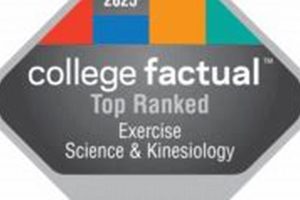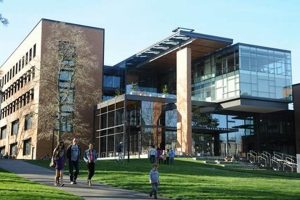Top-tier academic institutions offering graduate programs in communication sciences and disorders cultivate highly skilled professionals prepared to diagnose and treat individuals with speech, language, voice, and swallowing difficulties. These programs typically include rigorous coursework in anatomy and physiology, phonetics, linguistics, and clinical practice, often leading to a Master’s degree, a requirement for professional certification and licensure.
Graduates of highly ranked programs are equipped to address the complex communication needs of diverse populations across the lifespan, from early intervention with children to geriatric rehabilitation. Access to cutting-edge research, experienced faculty, and state-of-the-art clinical facilities distinguishes these institutions and contributes significantly to the advancement of the field. The demand for skilled practitioners continues to grow in response to increasing awareness of communication disorders and their impact on individuals’ quality of life.
This article will explore key factors to consider when selecting a graduate program, including program accreditation, faculty expertise, clinical opportunities, and research focus. Further discussion will delve into career paths available to graduates and the evolving landscape of speech-language pathology.
Tips for Selecting a Speech-Language Pathology Program
Choosing the right graduate program is crucial for aspiring speech-language pathologists. Careful consideration of several factors can ensure alignment with individual career goals and maximize professional development.
Tip 1: Verify Accreditation: Programmatic accreditation by the Council on Academic Accreditation in Audiology and Speech-Language Pathology (CAA) ensures adherence to rigorous academic and clinical standards.
Tip 2: Evaluate Faculty Expertise: Investigate faculty research interests and clinical specializations to find mentors aligned with specific areas of interest within the field.
Tip 3: Assess Clinical Opportunities: Diverse clinical experiences across a variety of settings (e.g., schools, hospitals, rehabilitation centers) provide comprehensive training and exposure to diverse client populations.
Tip 4: Consider Research Opportunities: Involvement in research projects can foster critical thinking skills and contribute to the advancement of knowledge within the field.
Tip 5: Explore Program Resources: Access to state-of-the-art clinical facilities, technology, and libraries enhances the learning experience.
Tip 6: Investigate Financial Aid Options: Explore scholarship opportunities, assistantships, and loan programs to mitigate the financial burden of graduate education.
Tip 7: Connect with Current Students and Alumni: Gain valuable insights into program culture, curriculum, and career outcomes through direct interaction with current students and alumni.
Careful evaluation of these factors will facilitate informed decision-making and contribute to a successful and fulfilling career in speech-language pathology.
By considering these tips, prospective students can identify programs best suited to their individual needs and aspirations, laying the foundation for a rewarding career.
1. Rigorous Curriculum
A rigorous curriculum is a defining characteristic of top-tier speech-language pathology programs. It provides students with a comprehensive and in-depth understanding of the field, encompassing theoretical foundations, clinical skills, and research methodologies. A demanding curriculum often includes advanced coursework in areas such as neurological disorders, dysphagia, voice science, and fluency disorders, pushing students beyond the basics and fostering critical thinking skills essential for effective clinical practice. For instance, programs may require in-depth study of neuroanatomy and its relationship to communication disorders, enabling graduates to accurately assess and treat clients with complex neurological conditions.
The intensity of the curriculum contributes significantly to the quality of graduates produced by these programs. Students are challenged to develop advanced clinical skills through extensive supervised clinical practicums, often exceeding the minimum requirements for certification. This intensive training ensures graduates possess the expertise and confidence to handle diverse client populations and challenging cases. For example, programs might incorporate intensive practicum experiences in specialized areas such as pediatric dysphagia or augmentative and alternative communication, providing students with focused training in these critical areas.
In summary, a rigorous curriculum serves as a cornerstone of excellence in speech-language pathology education. By challenging students intellectually and clinically, these programs cultivate highly skilled and competent professionals equipped to address the complex communication needs of diverse populations. This commitment to academic rigor ultimately benefits clients by ensuring they receive the highest quality care from well-prepared practitioners.
2. Experienced Faculty
A strong correlation exists between experienced faculty and highly regarded speech-language pathology programs. Faculty with extensive clinical and research backgrounds bring a wealth of knowledge and practical expertise to the classroom and clinical supervisory settings. Their experience translates into enriched learning experiences for students, fostering critical thinking and advanced clinical skill development. For example, faculty who have practiced extensively in specialized areas such as fluency disorders or pediatric dysphagia can provide students with nuanced insights and advanced clinical training in these areas. Furthermore, faculty actively engaged in research contribute to the advancement of the field and create opportunities for student involvement in cutting-edge projects. This exposure to research methodologies and innovative clinical practices enhances students’ problem-solving abilities and prepares them to contribute to the future of the profession.
The presence of experienced faculty significantly impacts program quality and student outcomes. Mentorship from seasoned professionals provides invaluable guidance as students navigate the complexities of clinical practice and research. Established faculty often have extensive networks within the field, facilitating connections for students seeking internships, research collaborations, and career opportunities. For instance, faculty members with connections to leading hospitals or rehabilitation centers can open doors for students to gain clinical experience in these prestigious settings. Moreover, experienced faculty often contribute to curriculum development, ensuring the program remains current with the latest advancements and best practices in the field. This commitment to innovation and continuous improvement benefits students by providing them with the most relevant and up-to-date education possible.
In summary, experienced faculty represent a critical component of high-quality speech-language pathology programs. Their expertise, mentorship, and professional networks enrich the learning environment and contribute significantly to student success. The presence of a distinguished faculty signals a program’s commitment to providing students with a comprehensive and enriching education, ultimately leading to a more skilled and prepared workforce capable of meeting the evolving demands of the field.
3. Diverse Clinical Placements
A hallmark of leading speech-language pathology programs is the provision of diverse clinical placements. Exposure to a wide range of client populations and clinical settings is essential for developing well-rounded and adaptable clinicians. Experiences in hospitals, schools, rehabilitation centers, private practices, and community clinics provide students with opportunities to apply theoretical knowledge to practical situations, honing clinical skills and fostering professional growth. For example, placements in a neonatal intensive care unit allow students to develop specialized skills in early intervention for infants with feeding and swallowing difficulties, while placements in a school setting offer experience in managing childhood language disorders. This breadth of experience fosters adaptability and prepares graduates for the diverse demands of the profession.
The variety of clinical placements directly impacts the quality of graduate training. Working with diverse client populations, including individuals with varying ages, communication disorders, and cultural backgrounds, cultivates cultural sensitivity and enhances clinical decision-making skills. Exposure to different service delivery models, such as individual therapy, group therapy, and interdisciplinary collaboration, broadens perspectives and strengthens professional competence. Furthermore, diverse placements provide opportunities to network with experienced professionals in different settings, fostering potential mentorship and career opportunities. For instance, a placement in a research-oriented hospital may expose students to cutting-edge treatment approaches and research opportunities, potentially influencing future career paths.
In conclusion, diverse clinical placements are integral to a comprehensive speech-language pathology education. These experiences contribute significantly to professional development, fostering adaptability, clinical competence, and cultural sensitivity. Graduates with exposure to a wide range of clinical settings are well-equipped to meet the complex needs of diverse client populations and contribute meaningfully to the field. The availability and quality of clinical placements are therefore key indicators of a program’s commitment to providing high-quality training and preparing graduates for successful careers.
4. Cutting-Edge Research
A strong emphasis on cutting-edge research distinguishes top speech-language pathology programs. Institutions committed to advancing the field prioritize research activity, fostering an environment of inquiry and innovation that benefits both students and the profession as a whole. This commitment translates into opportunities for students to engage in meaningful research experiences, contributing to the development of new knowledge and improved clinical practices.
- Faculty Research Expertise:
Leading programs employ faculty actively engaged in cutting-edge research across various subfields of speech-language pathology. This expertise exposes students to diverse research methodologies and innovative clinical approaches. For instance, faculty might specialize in areas such as using virtual reality for aphasia treatment or investigating the genetic basis of stuttering. This exposure can inspire student research interests and provide opportunities for mentorship and collaboration on impactful projects.
- State-of-the-art Research Facilities:
Advanced research facilities are crucial for conducting high-quality research. These facilities often include specialized laboratories equipped with cutting-edge technology, such as eye-tracking systems, acoustic analysis software, and brain imaging equipment. Access to these resources allows students to acquire advanced research skills and contribute to impactful studies. For example, students might use eye-tracking technology to investigate language processing in children with autism or utilize acoustic analysis software to study voice disorders.
- Student Research Opportunities:
Top programs offer numerous opportunities for students to engage in research. These opportunities can include assisting faculty on research projects, conducting independent research under faculty supervision, and presenting research findings at conferences. Such experiences cultivate critical thinking skills, enhance problem-solving abilities, and contribute to professional development. For instance, students might present their research on the effectiveness of a new intervention for language delays at a national conference, gaining valuable experience in disseminating research findings.
- Integration of Research into Clinical Practice:
Leading programs emphasize the integration of research findings into clinical practice. This ensures that students are trained in evidence-based approaches and understand the importance of using research to inform clinical decision-making. This emphasis on evidence-based practice prepares graduates to provide the highest quality care informed by the latest scientific advancements. For example, programs might incorporate coursework on critically evaluating research literature and applying research findings to clinical case studies.
In summary, a strong research focus significantly enhances the quality of a speech-language pathology program. By providing students with opportunities to engage in cutting-edge research, these programs cultivate critical thinking, advance knowledge within the field, and prepare graduates to become leaders in the profession. The emphasis on research distinguishes leading programs and underscores their commitment to innovation and excellence in both clinical practice and scientific inquiry.
5. Advanced Facilities
A strong correlation exists between access to advanced facilities and the quality of speech-language pathology programs. State-of-the-art equipment and specialized spaces significantly enhance the educational experience, allowing students to develop advanced clinical skills and engage in cutting-edge research. These facilities often include sophisticated instrumentation for assessing and treating communication disorders, such as voice analysis software, videofluoroscopic swallowing studies equipment, and auditory brainstem response systems. For example, access to computerized speech labs allows students to analyze speech acoustics and articulation patterns with precision, leading to more accurate diagnoses and targeted treatment plans. Similarly, specialized clinical simulation labs provide opportunities to practice therapeutic techniques in realistic settings, fostering confidence and competence before working with actual clients.
The availability of advanced facilities directly impacts the practical skills and research capabilities of graduates. Experiences with cutting-edge technology prepare students to utilize these tools effectively in clinical practice, ensuring they can provide the highest quality care using the latest advancements in the field. Furthermore, access to research-grade equipment allows students to participate in sophisticated research projects, contributing to the advancement of knowledge and the development of innovative clinical approaches. For instance, students might use electroencephalography (EEG) equipment to study brain activity during language processing, leading to a deeper understanding of neurological underpinnings of communication disorders. This integration of advanced technology into both clinical training and research activities elevates the overall quality of the educational experience.
In summary, advanced facilities are a critical component of leading speech-language pathology programs. Access to state-of-the-art equipment and specialized learning spaces enhances clinical training, fosters research opportunities, and prepares graduates to excel in a rapidly evolving field. Institutions prioritizing investment in these resources demonstrate a commitment to providing students with a superior educational experience, ultimately benefiting both the graduates and the clients they serve. The presence of advanced facilities should therefore be a key consideration for prospective students evaluating speech-language pathology programs.
Frequently Asked Questions
This section addresses common inquiries regarding the pursuit of a degree in speech-language pathology from a top-tier institution.
Question 1: What distinguishes top programs from others?
Distinguished programs typically offer rigorous curricula, experienced faculty, diverse clinical placements, opportunities for cutting-edge research, and advanced facilities. These factors contribute to a comprehensive and enriching educational experience.
Question 2: How important is program accreditation?
Accreditation by the Council on Academic Accreditation in Audiology and Speech-Language Pathology (CAA) is crucial. It signifies that a program meets stringent national standards for academic and clinical training, ensuring a high-quality education.
Question 3: What are the career prospects for graduates of highly ranked programs?
Graduates often have a competitive edge in the job market, with access to a wider range of employment opportunities in diverse settings such as hospitals, schools, rehabilitation centers, and private practices. Highly ranked programs often cultivate strong alumni networks, further enhancing career prospects.
Question 4: How can one determine if a specific program aligns with individual career goals?
Thorough research is essential. Investigating faculty expertise, clinical placements offered, and research specializations within a program can help determine alignment with individual interests and long-term career aspirations. Connecting with current students and alumni can provide valuable insights into program culture and career outcomes.
Question 5: What role does research play in graduate programs?
Involvement in research fosters critical thinking skills and contributes to the advancement of the field. Top programs often offer opportunities for students to participate in research projects, potentially leading to publications and presentations at professional conferences. This experience can be invaluable for those considering pursuing doctoral studies.
Question 6: What are the key factors to consider when choosing a program?
Key considerations include program accreditation, faculty expertise, clinical opportunities, research focus, available resources, financial aid options, and program culture. A comprehensive assessment of these factors will contribute to informed decision-making.
Careful consideration of these frequently asked questions provides a foundation for prospective students navigating the process of selecting a speech-language pathology program. Further research and consultation with academic advisors are recommended.
The subsequent section will explore specific examples of institutions renowned for their speech-language pathology programs.
Best Schools for Speech Language Pathology
Selecting among the best schools for speech language pathology represents a pivotal decision for aspiring clinicians. This exploration has highlighted key factors distinguishing exceptional programs, including rigorous curricula, experienced faculty, diverse clinical placements, cutting-edge research opportunities, and advanced facilities. These elements collectively contribute to comprehensive training, preparing graduates to address the complex communication needs of diverse populations effectively.
The demand for highly skilled speech-language pathologists continues to grow, underscoring the importance of selecting a program that fosters professional excellence. A commitment to lifelong learning and ongoing professional development remains essential for practitioners seeking to provide the highest quality care in this evolving field. Informed decision-making regarding educational pathways will shape the future of communication sciences and disorders, ensuring individuals with communication challenges receive optimal support and services.







